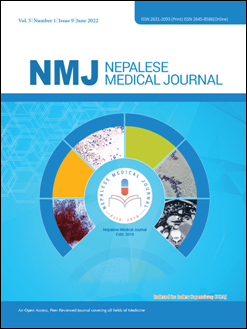Pap Smear as a Screening Tool for Cervical Cancer in a Tertiary Care Centre in Nepal: A Retrospective Cross-sectional Analysis
DOI:
https://doi.org/10.3126/nmj.v5i1.46421Keywords:
Carcinoma, Cervix, Pap smearAbstract
Introduction: Pap smear is a time-tested screening test to diagnose cervical carcinoma at an early stage. It allows clinicians to take intervention measures, prevent the progression of the disease to invasive forms and decrease the burden of carcinoma as a whole. The objective of this study is to determine the values regarding the diagnostic accuracy of Pap smear and establish its role in the health care setting of Nepal.
Materials and Methods: This is a retrospective cross-sectional analysis of the records from April 14, 2018, to April 12, 2020, of the Department of Pathology in a tertiary care hospital in the capital city of Nepal. Ethical approval for the study was taken from the Institutional Review Board and the demographic and clinical data of patients were analyzed anonymously. The consecutive sampling technique as used for data collection and analysis was done in Microsoft Excel 2019 and Statistical Packages for Social Sciences Version 25. The diagnostic accuracy parameters were calculated from a contingency table prepared from the collected data.
Results: Out of 3095 Pap smears, 72 had a positive finding of some sort. 74 cases had a positive finding in the form of a biopsy out of 573. The sensitivity, specificity, positive predictive value, and negative predictive value of Pap smear at the institution were found to be 0.70, 0.94, 0.78, and 0.91 respectively with an overall accuracy of 88.36%.
Conclusions: Pap smear can still play a pivotal role in the diagnosis of cervical neoplastic lesions.
Downloads
Downloads
Published
How to Cite
Issue
Section
License
Copyright (c) 2022 Amar Narayan Shrestha, Anurag Adhikari, Ayusha Poudel, Barun Babu Aryal, Ganesh Parajuli, Suman Gurung, Shreejana Baskota, Ishu Shrestha

This work is licensed under a Creative Commons Attribution 4.0 International License.
This license enables reusers to distribute, remix, adapt, and build upon the material in any medium or format, so long as attribution is given to the creator. The license allows for commercial use.
Copyright on any article published by Nepalese Medical Journal is retained by the author(s).
Authors grant Nepalese Medical Journal a license to publish the article and identify itself as the original publisher.
Authors also grant any third party the right to use the article freely as long as its integrity is maintained and its original authors, citation details and publisher are identified.




